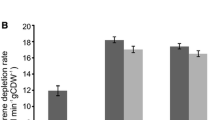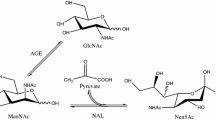Abstract
Transaminase responsible for alienating prochiral ketone compound is applicable to asymmetric synthesis of herbicide L-phosphinothricin (L-PPT). In this work, the covalent immobilization of recombinant transaminase from Citrobacter koseri (CkTA) was investigated on different epoxy resins. Using optimum ES-105 support, a higher immobilized activity was obtained via optimizing immobilization process in terms of enzyme loading, coupling time and initial PLP concentration. Crucially, due to blocking unreacted epoxy groups on support surface with amino acids, the reaction temperature of blocked immobilized biocatalyst was enhanced from 37 to 57 °C. Its thermostability at 57 °C was also found to be superior to that of free CkTA. The Km value was shifted from 36.75 mM of free CkTA to 39.87 mM of blocked immobilized biocatalyst, demonstrating that the affinity of enzyme to the substrate has not been apparently altered. Accordingly, the biocatalyst performed the consecutive synthesis of L-PPT for 11 cycles (yields>91%) with retaining more than 91.13% of the initial activity. The seemingly the highest reusability demonstrates this biocatalyst has prospective for reducing the costs of consecutive synthesis of L-PPT with high conversion.







Similar content being viewed by others
References
Bayer E, Gugel KH, Hägele K, Hagenmaier H, Jessipow S, König WA, Zähner H (1972) Stoffwechselprodukte von mikroorganismen. 98. mitteilung. Phosphinothricinund phosphinothricyl-alanyl-alanin. Helv Chim Acta 55:224–239
Fraser AR, Ridley SM (1984) Kinetics for glutamine-synthetase inhibition by phos-phinothricin and measurement of other enzyme activities in situ in isolated asparagus cells using a freeze-thaw technique. Planta 161:470–474
Xue YP, Cao CH, Zheng YG (2018) Enzymatic asymmetric synthesis of chiral amino acids. Chem Soc Rev 47:1516–1561
Jia DX, Liu ZJ, Xu HP, Li JL, Li JJ, Jin LQ, Cheng F, Liu ZQ, Xue YP, Zheng YG (2019) Asymmetric synthesis of l-phosphinothricin using thermostable alpha-transaminase mined from Citrobacter koseri. J Biotechnol 302:10–17
Koszelewski D, Tauber K, Faber K, Kroutil W (2010) ω-Transaminases for the synthesis of non-racemic α-chiral primary amines. Cell 28:324–332
Kelly SA, Megaw J, Caswell J, Scott CJ, Allen CCR, Moody TS, Gilmore BF (2017) Isolation and characterisation of a halotolerant ω-transaminase from a triassic period salt mine and its application to biocatalysis. Chemistryselect 2:9783–9791
Schulz A, Taggeselle P, Tripier D, Bartsch K (1990) Stereospecific production of the herbicide phosphinothricin (glufosinate) by transamination: isolation and characterization of a phosphinothricin-specific transaminase from Escherichia coli. Appl Environ Microbiol 56:1–6
Taylor PP, Pantaleone DP, Senkpeil RF, Fotheringham IG (1998) Novel biosynthetic approaches to the production of unnatural amino acids using transaminases. Trends Biotechnol 16:412–418
Jin LQ, Peng F, Liu HL, Cheng F, Jia DX, Xu JM, Liu ZQ, Xue YP, Zheng YG (2019) Asymmetric biosynthesis of L-phosphinothricin by a novel transaminase from Pseudomonas fluorescens ZJB09-108. Process Biochem 85:60–67
Barig S, Funke A, Merseburg A, Schnitzlein K, Stahmann KP (2014) Dry entrapment of enzymes by epoxy or polyester resins hardened on different solid supports. Enzyme Microb Technol 60:47–55
Khanahmadi S, Yusof F, Amid A, Mahmod SS, Mahat MK (2015) Optimized preparation and characterization of CLEA-lipase from cocoa pod husk. J Biotechnol 202:153–161
Martin AR, Shonnard D, Pannuri S, Kamat S (2007) Characterization of free and immobilized (S)-aminotransferase for acetophenone production. Appl Microbiol Biotechnol 76:843–851
Andrade LH, Kroutil W, Jamison TF (2014) Continuous flow synthesis of chiral amines in organic solvents: immobilization of E. coli cells containing both ω-transaminase and PLP. Org Lett 16:6092–6095
Torres P, Batista-Viera F (2012) Immobilization of β-galactosidase from Bacillus circulans onto epoxy-activated acrylic supports. J Mol Catal B Enzym 74:230–235
Mateo C, Grazú V, Pessela BCC, Montes T, Palomo JM, Torres R, López-Gallego F, Fernández-Lafuente R, Guisán JM (2007) Advances in the design of new epoxy supports for enzyme immobilization-stabilization. Biochem Soc Trans 35:1593–1601
Li XX, Li DM, Wang WF, Durrani R, Yang B, Wang YH (2016) Immobilization of SMG1-F278N lipase onto a novel epoxy resin: characterization and its application in synthesis of partial glycerides. J Mol Catal B Enzym 133:154–160
Zou SP, Gu K, Zheng YG (2018) Covalent immobilization of halohydrin dehalogenase for efficient synthesis of epichlorohydrin in an integrated bioreactor. Biotechnol Biotechnol Prog 34:784–792
Li Y, Gao F, Wei W, Qu JB, Ma GH, Zhou WQ (2010) Pore size of macroporous polystyrene microspheres affects lipase immobilization. J Mol Catal B Enzym 66:182–189
Miletić N, Vuković Z, Nastasović A, Loos K (2009) Macroporous poly(glycidyl methacrylate-co-ethylene glycol dimethacrylate) resins-versatile immobilization supports for biocatalysts. J Mol Catal B Enzym 56:196–201
Fan C, Li JL, Zhu XY, Li N, Wang W, Guo L, Luo Q (2012) Studies on immobilization of penicillin G acylase to epoxy resin. Adv Mater Res 512–515:1699–1711
Mihailović M, Stojanović M, Banjanac K, Carević M, Prlainović N, Milosavić N, Bezbradica D (2014) Immobilization of lipase on epoxy-activated purolite® A109 and its post-immobilization stabilization. Process Biochem 49:637–646
Wang LH, Zhao YM, Zhang YY, Zhang TT, Kool J, Somsen GW, Wang QQ, Jiang ZJ (2018) Online screening of acetylcholinesterase inhibitors in natural products using monolith-based immobilized capillary enzyme reactors combined with liquid chromatography-mass spectrometry. J Chromatogr A 1563:135–143
Bezsudnova EY, Stekhannova TN, Popinako TV, Nikolaeva AY, Boyko KM, Popov VO (2018) Diamino pelargonic acid transaminase from psychrobacter cryohalolentis is active towards (S)-(-)-1-phenylethylamine, aldehydes and α-diketones. Appl Microbiol Biotechnol 102:9621–9633
Zhang XJ, Fan HH, Liu N, Wang XX, Cheng F, Liu ZQ, Zheng YG (2019) A novel self-sufficient biocatalyst based on transaminase and pyridoxal 5′-phosphate covalent co-immobilization and its application in continuous biosynthesis of sitagliptin. Enzyme Microb Technol 130:531–540
Illanes A, Wilson L, Tomasello G (2001) Effect of modulation of enzyme inactivation on temperature optimization for reactor operation with chitin-immobilized lactase. J Mol Catal B Enzym 11:531–540
Hooda PV (2014) Immobilization and kinetics of catalase on calcium carbonate nanoparticles attached epoxy support. Appl Biochem Biotechnol 172:115–130
Mendes AA, Castro HFD, Andrade GSS, Tardioli PW, Giordano RDLC (2013) Reparation and application of epoxy-chitosan/alginate support in the immobilization of microbial lipases by covalent attachment. React Funct Polym 73:160–167
Zhou X, Han Y, Lv Z, Tian X, Li H, Xie P, Zheng L (2017) Simultaneously achieve soluble expression and biomimetic immobilization of candida antarctica lipase B by introducing polyamine tags. J Biotechnol 249:1–9
Vanessa VB, Jazmaz MVB, Joszma ASH, Marsz EHL (2008) Immobilization of the recombinant invertase INVB from Zymomonas mobilis on nylon-6. J Ind Microbiol Biotechnol 35:1289–1295
Morana A, Mangione A, Maurelli L, Fiume I, Paris R, Raris O, Cannio R, Rossi M (2006) Immobilization and characterization of a thermostable β-xylosidase to generate a reusable biocatalyst. Enzyme Microb Technol 39:1205–1213
Chen Q, Liu D, Wu C, Yao K, Li Z, Shi N, Wen F, Gates ID (2018) Co-immobilization of cellulase and lysozyme on amino-functionalized magnetic nanoparticles: an activity-tunable biocatalyst for extraction of lipids from microalgae. Bioresour Technol 263:317–324
Jia DX, Zhou L, Zheng YG (2017) Properties of a novel thermostable glucose isomerase mined from Thermus oshimai and its application to preparation of high fructose corn syrup. Enzyme Microb Technol 99:1–8
Jia DX, Wang T, Liu ZQ, Jin LQ, Li JJ, Liao CJ, Chen DS, Zheng YG (2018) Whole cell immobilization of refractory glucose isomerase using tris(hydroxymethyl)phosphine as crosslinker for preparation of high fructose corn syrup at elevated temperature. J Biosci Bioeng 126:176–182
Gao Y, Truong YB, Cacioli P, Butler P, Kyratzis IL (2014) Bioremediation of pesticide contaminated water using an organophosphate degrading enzyme immobilized on nonwoven polyester textiles. Enzyme Microb Technol 54:38–44
Lin L, Bai YX, Li YF, Yi LX, Yang Y, Xia CG (2008) Study on immobilization of lipase onto magnetic microspheres with epoxy groups. J Magn Magn Mater 321:252–258
Acknowledgements
This project was financially supported by the National Defense Science and Technology Innovation Zone Foundation of China, and the Natural Science Foundation of China [Grant numbers 21978268, 31700693].
Author information
Authors and Affiliations
Corresponding author
Ethics declarations
Conflict of interest
The authors declare that they have no conflict of interest.
Additional information
Publisher's Note
Springer Nature remains neutral with regard to jurisdictional claims in published maps and institutional affiliations.
Rights and permissions
About this article
Cite this article
Jia, DX., Xu, HP., Sun, CY. et al. Covalent immobilization of recombinant Citrobacter koseri transaminase onto epoxy resins for consecutive asymmetric synthesis of L-phosphinothricin. Bioprocess Biosyst Eng 43, 1599–1607 (2020). https://doi.org/10.1007/s00449-020-02351-3
Received:
Accepted:
Published:
Issue Date:
DOI: https://doi.org/10.1007/s00449-020-02351-3




